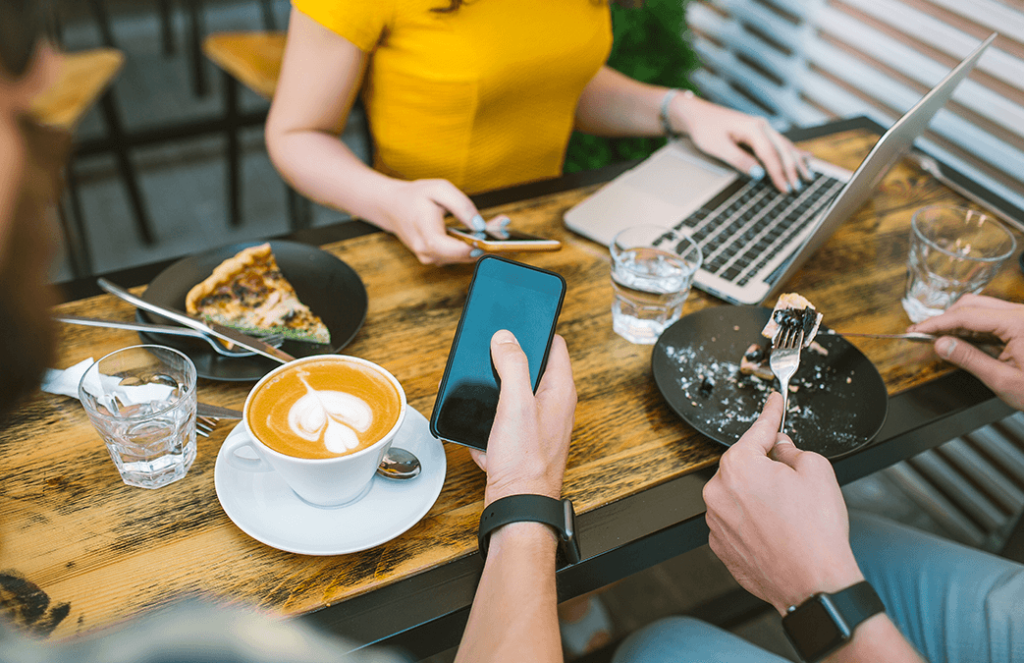[vc_row][vc_column][vc_column_text]Anyone visiting Europe these days will likely have noticed the differences in the way Europeans and Americans handle card payments in restaurants. Most restaurants in the US still bring your check to the table in a wallet to place your card in, come back later to take your card to the point-of-sale system, swipe it, bring the printed check back to the table and leave it to be signed, and for you to add the tip, of course.
But in Europe, paying by card generally means a server will take your payment at the table using a card reader that you enter a PIN number into, or tap a contactless credit card or mobile against. This is driven by EMV compliance, the global standard for payment cards equipped with chips and the technology used to authenticate the transactions they make. The shift towards EMV compliance also means operators are having to update their POS systems, which is driving the adoption of tableside payment options.
The rise in tableside payment
As US operators look to comply with EMV standards, many are beginning to shift towards the European model of bringing the payment device to the table in the form of a tableside POS or card reader. This change comes as customer payment preferences are changing towards payments that require some form of security step, such as finger-print ID.
But does tableside payment in this form really meet the demands of the modern American consumer? The US public expects seamless interactions. Studies show that 56% of consumers are willing to share data to receive a faster and more convenient service, while 84% say a quick and efficient service is important in judging dining experiences.
Time spent setting up and processing payments at the tableside is both dead time for the operator, and frustrating from the guest-perspective. Indeed, 69% of restaurant-goers find waiting for the check the most frustrating part of eating out, which is understandable when you take into account that, on average, it takes 12 minutes from asking for the check to paying it. The harsh reality is that tableside POS payment does little to reduce this waiting time, as it still requires most of the steps previously required for a traditional card payment. Using tableside POS can even create additional delays if servers have limited access to payment devices and have to wait for colleagues to finish using them.
Another consideration is tipping culture. With more card payments being taken at the table in the US, many guests are uncomfortable with the presumption implied by displaying a tip entry, in addition to having the server standing over them while they punch in their tip percentage.
To meet consumer demand, restaurants need to offer a range of tableside payment options to suit their guests’ preferences. Cash is still the fastest way to exit a restaurant, but we know what is happening to cash. And, if the goal is to improve speed and efficiency of card payments, there is still a significant amount of drag in a tableside POS model that requires a server bringing a card machine to the table.
Enabling contactless mobile payment at the table
Clearly, offering guests an option to pay quickly, from their table and in their own time, is highly desirable. And the fastest route to achieving this is via their smartphone.
An estimated 31% of iPhone users made a purchase using Apple Pay in the 2018, while 47% of consumers expect to be using mobile payment and digital wallets by 2020. The rise seen in mobile payments and digital wallets is not only attributed to the increased safety that biometric authentication provides. It also comes as society is beginning to expect seamless, one-click or voice activated payments – just see the success of Amazon, the rapid growth in the Internet of Things, and the rise of contactless payments in Europe, where one in every two transactions are now tap to pay.
But, if you still have to wait for a server to bring bring the tableside POS device to the table to take your contactless phone payment, you aren’t really saving any time at all.
And, while it works well in certain cases, the traditional mobile app model is relatively high friction – requiring you to download an app and often to register your details for an account, when most of the time you just want to do something quick and simple, like ordering and paying for a meal. In many cases, customers will simply not bother to download an app to avoid the hassle of downloading yet another app and cluttering up their phone even further.
What if the table was a contactless payment device?
At QikServe we believe that the smartphone is the most powerful payment device in restaurants. Our approach removes friction by allowing guests to use their own mobile devices to pay from their table, but, crucially, with no apps required. By placing a small NFC tag or QR code on to the surface we can turn any table into a payment terminal.
Guests check-in at their table by tapping their smartphone on an NFC point or scanning a QR code, using the phone’s native capabilities (again, no downloads required). This automatically connects their phone to the restaurant point of sale and brings up a digital version of their check on a secure web page for rapid payment. Customers can review their bill, split it and add tip as necessary.

The whole payment experience is faster and easier than using a tableside POS. The solution is fully integrated with the point of sale, payment provider and the table management system to create a seamless experience that requires no input from wait staff. Simplicity is key. With our pay-at-table approach, the time from check-in to payment takes well under a minute, by enabling a contactless phone payment at table.
Contactless pay at table by phone delivers:
- Reduced waiting time. Eliminate the dead time associated with serving staff going back and forth between table and the POS to slash the time guests spend waiting for service.
- Reduced hardware costs. Allowing guests to use their own mobile devices significantly reduces the costs associated with running multiple tableside POS devices.
- Fewer instances of dine & dash. If guests leave without paying it’s often down to the length of time it takes to get the check from the server, or because they simply forget. Mobile pay at table addresses both of these issues, by giving guests the flexibility to pay how they want, when they want, and by offering a visual reminder for guests to pay in the form of the QR code/NFC tag on the table.
- No change to tipping culture. By allowing guests to incorporate tipping into the payment journey on their own phone, you’re removing the discomfort that they may feel from tipping on a tableside POS.
- Provide a whole new way to pay. Leaving staff free to focus on providing a high level of customer service.
- A segway into other digital experiences. If guests get comfortable using one of your digital channels it can be the gateway into onboarding them onto others, such as a loyalty or rewards scheme.
[/vc_column_text][vc_separator color=”white”][/vc_column][/vc_row][vc_row][vc_column][/vc_column][/vc_row]





